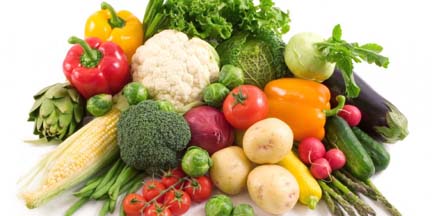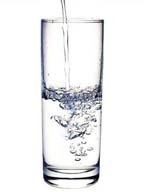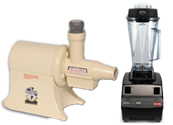A Healthy Kitchen
by
Mary Louise;Town Jaqua, Health Minister 7/11/11It has been said that the kitchen
is the most important room of the house: the birthplace
of great ideas, the forum for great discussions, the
meeting place of minds, and most of all, the nuturing
center of the household. Thus the kitchen is well
regarded as being the heart of the home where goodness of
life orginates.This being true, why not make this
important, most-
frequented room of the house a veritable wellspring for
optimum health?
A
HEALTHY KITCHEN: what is it?
A healthy kitchen is a naturally wholesome
environment that is dedicated to nourishing the body and
spirit toward wellbeing and longevity. Building a healthy
space to encourage the principles of natural nourishment
requires time, effort, finances, and most of all understanding.
While the basics of a healthy kitchen are simple, certain
guidelines do apply.

A HEALTHY KITCHEN: what is there to
eat?
A healthy kitchen has healthy, living
food! Fresh, raw fruit,
vegetables, seeds, nuts, and whole grains are found in
abundance in a healthy kitchen. The refigerator is
well-stocked with life-giving foods such as kale,
collards, lettuce, broccoli, cauliflower, beets, carrots,
celery, tomatoes, parsnips, apples, bananas, melons,
pears, peaches, grapes, almonds, walnuts, cashews, sesame
seeds, hemp and chia seeds, and more. Whole grains such
as brown rice, buckwheat groats, quinoa, rye, oats and
other dry
goods sit on pantry shelves as do herbs and spices such
as oregano, basil, cinnamon, cumin, curry, tarragon,
thyme, coriander, nutmeg, cayenne, fennel, all spice, and
more.
 VS. VS.

Conspicuously absent in a
healthy kitchen are animal-based foods (meat, dairy,
seafood) and man-made, processed, fast foods. A healthy
kitchen generates and promotes natural nourishment YHVH's
way as recorded in Genesis 1:29.
And YHVH said, Behold, I
have given you
every herb bearing seed, which is upon
the face of all the earth, and every tree,
n the which is the fruit of a tree yielding
seed; to you it shall be for meat (food).
A healthy
kitchen is established in accordance with YHVH's first
law which, when obeyed, promises to bless man with all
good health and prosperity. This law established a
plant-based diet of raw, fresh fruit, vegetables, seeds,
nuts and whole grains that builds a body that is strong,
self-healing, and resistant to sickness and disease.
Science proves that a diet of fresh, raw, living foods
optimizes energy, clarity of thought, stablizes emotions,
and strengthens the immune system. Living foods contain
the life force that leads to optimum health and
longevity.

A HEALTHY KITCHEN has healthy
drinking water
When it comes to issues of health, safe and
affordable drinking water in the home is mandatory. The
harmful affects of municipal tap water are well known and
therefore need to be avoided which means investing in a
personal water purification system. Commercially-bottled
water is not recommended, since the water source is
questionable and typically the pH of bottled drinking
water is highly acidic. The preferred source for drinking
water is spring water, since it rises on its own volition
from deep within the earth. Well water is also a good
drinking water source, though pre and periodic testing is
recommended. Distilled water is also another option for
healthy drinking water.
A HEALTHY KITCHEN has health-minded equipment

Having the right tools at hand makes life easier and more
enjoyable, especially when it comes to food preparation.
Found in a healthy kitchen are
a few basic appliances: a juicer, blender, food
processor, and dehydrator. While it is possible to eat
healthy without these conveniences, having good equipment
aids and enhances the culinary process.

A healthy kitchen also has quality knives. There is
nothing like a good knife in order to get the job done
and done right. Names to look for are Hoffritz,
Wusthof, and Sabatier. There are also ceramic knives
which, according to some raw chefs, are superior in that
they hold an edge better, cut and handle more easily, and
food does not oxidize as quickly after being cut.
A healthy
kitchen does not sport nor support aluminum or
teflon-coated pots, pans, tea kettles, muffin tins or
utensils. Replace toxic items with glass,
enamel or stainless steel ware.
If the budget
does not allow for buying high-end equipment, make a
healthy start by shopping local discount stores, thrift
stores, and yard sales for equipment that you need. A
small investment pays big dividends.
A HEALTHY KITCHEN: tips and tidbits
Gaining knowledge and experience in handling and
preparing living food takes time and, in most cases,
practice. Those transitioning to a living foods diet are
admittedly charting new, unknown territory. Nevertheless,
eating healthy is often the result of common sense
coupled with a little gathered know-how.
1)
Live food, by definition, is alive. As soon as food is
harvested from tree, plant, vine or ground, it begins to
lose its nutritional value. Therefore, consider the time
element in preparing food. When harvesting from your
garden, pick only what you will eat within a day or two.
The same holds true for what is purchased from local
farmers. Produce in supermarkets is weeks if not months
old, since most of it has been trucked from miles away.
2) Considering the perishability of
living food, as much as possible prepare only what will
be eaten immediately. Making meals in advance is not
optimum. Nevertheless, busy lifestyles can demand
otherwise. Better and healthier it is to pack a lunch
and/or snack the night before or day in advance than
compromise healthy eating away from home. Therefore plan
a meal strategy for eating at the office or being on the
road. 'Grab-and-go' salads, snacks, and fruit are good
solutions when being 'on-the-run.' As much as possible,
'take your kitchen with you!'
3) Store fresh produce in glass, enamel,
and plastic containers or in green 'stay-fresh' bags. Any
plastic used in the kitchen should be food grade (stamped
with a numeral '5' on the underside). Glass and enamel
cover dishes make excellent storage, especially for left
overs. Glass jars are good for storing smoothies, raw
soups, juices, and dry goods. Gallon glass jars make
handy storage and can usually be picked up at Delis,
garage sales or
in thrift stores. For optimum storage of fresh produce
(especially greens), keep them at an even, cool
temperature in the refrigerator as opposed to an
ice chest.
4) Greens
that become limp can sometimes be revived by soaking them
in cold water. Soak for about 15 minutes, drain in a
colander, then place in a plastic bag or storage
container in the refrigerator. In a short time, the
leaves will crisp up. Soft/limp root vegetables usually
do not regain their firmness and therefore should be
eaten immediately or discarded.
5) Recipes that call for blending or using a
juicer to make nut butters/grain dishes can instead be
finely chopped/blended in a food processor.
6)
Make your kitchen a pleasant place in which to be by
choosing inspiring decor. Repaint or put up new wallpaper
to celebrate your healthy lifestyle. Hang favorite
artwork and set the table with colorful cloths/napkins.
Buy fresh flowers on occasion. Special touches add warmth
to a kitchen.
A HEALTHY KITCHEN is a clean kitchen
'Eating clean' begins with washing all produce prior to
preparation. Many non-toxic vegetable/ fruit washes are
available on the market.
Kitchen
counters, preparation surfaces (especially cutting
boards) should be cleaned and disinfected thoroughly
after use. Recommended low-cost cleaning agents include
food-grade Hydrogen Peroxide, a vinegar/water solution or
an essential oil solution. Food grade oregano oil is also
good for disinfecting cutting boards and food prep areas.
Add a couple drops to wash water or use it as a spray.
To combat
mold build up, especially in refrigerators, use Thieves
essential oil from Young Living. A few drops in hot wash
water or the Thieves spray will
eradicate mold spores anywhere. Likewise a small bowl of
baking soda in the refigerator can absorb unpleasant,
potentially harmful odors.
For
multipurpose cleaning in the kitchen use plant-based
liquid concentrates that are user and
environmentally-friendly because they contain no harmful
chemicals. Many such products are available on the
market.
A HEALTHY KITCHEN has healthy
resources
Everyone loves a good recipe! Investing in a few, choice
recipe books is often the key to building lasting,
healthier eating habits. Healthy recipe books are good
references for wholesome meal ideas and preparation
instructions. Gleaning knowledge from veteran raw chefs
is not only inspiring but practical.
A HEALTHY KITCHEN uses natural first
aid
Accidents can and do happen when preparing food.
A slip of the knife, a burn, a bump or bruise can
necessitate instant remedy. With the right know-how and
natural solutions an injury can be quickly addressed.
To stop
bleeding apply cayenne pepper, raw honey, calcium
Bentonite clay or a drop of Balsam Fir Young
Living essential oil on the cut. The latter works
instantly. For burns apply Lavendar essential oil,
Miracle II Gel, Willard Water Gel and/or Aloe. If applied
immediately, the chance of scarring is greatly reduced if
not eliminated. Lavendar essential oil is also good for
bruises, lessening inflammation (pain) and speeding the
healing process.
Injuries of
all kinds, including cuts, burns, bruises, and broken
bones can also be remedied by applying lymphatic
techiniques, i.e. stroking the affected
area to remove trapped blood proteins (which cause
inflammation/pain) and speed healing. The remarkable
ability of the body to heal itself by properly activating
the lymphatic system was pioneered by Dr. Samuel West who
founded the International Academy of Lymphology.
A HEALTHY KITCHEN is a happy place
Feeding others is a noble task as well as an art. It is
also a privilege. Handling living foods should be
considered an honor, since these foods are custom made
for us by YHVH Himself. Therefore handle the food you
have purchased with care and thanksgiving. Preparing
meals for yourself and your family should be a joyous
experience, since 1) you have been shown what to eat for
your ultimate health, and 2) you have food. While many in
America and around the world are going hungry, count it a
blessing to have food.
Avoid family
food wars. Resolve to make the kitchen a haven of love,
peace, and rest. Do not prepare food if you are sick,
upset or angry. A bad attitude has a toxic affect on food
and is passed along to the eaters. As much as lies within
you, prepare food as a ministry unto YHVH for the good of
those whom you serve, then what comes out of your kitchen
will not only taste better but will nourish the spirit as
well as the body!
Whatever you do, work at it
with all
your heart, as working for the YHVH,
not for men. Colossians 3:23 (NIV)
A merry heart doeth good
[like] a
medicine: but a broken spirit drieth
the bones. Proverbs 17:22
O taste and see that YHVH[is] good:
blessed [is] the man[that] trusteth in
him. Psalm 34:8
________________________________
For product information and more visit
My Hallelujah Diet or LIVING
Buying
Living Letter #134/index
|
 VS.
VS.


